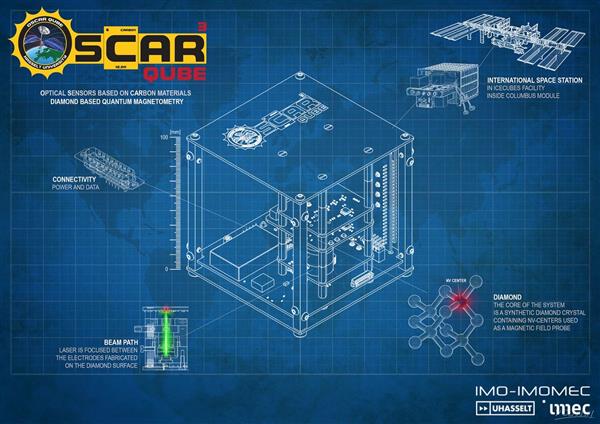project OSCAR-QUBE
About the team
OSCAR-QUBE is a multidisciplinary team of 15 students from Hasselt University (Belgium, Diepenbeek) that is currently developing a new generation of magnetic field sensors that works on the quantum principles. The students in the team take on challenges in fields of electronics and mechanical engineering, as well as software and physics aspects. For further information please refer to the links below:
project OSCAR-QUBE Facebook page
Orbit Your Thesis! ESA Selection results
The experiment
Quantum technologies - The next frontier in technological advancement is not only quantum computing or encryption. Quantum sensing technologies enable the measurement of physical quantities using quantum properties of materials. This results in “digital” drift-free measurements. It enables the accurate measurement of external fields, with high sensitivity, across a broad frequency spectrum. Further development of this technology and the widespread use of quantum sensing will enrich both space and terrestrial applications, such as, for example, navigation, communication or healthcare, and might lead to new discoveries and space exploration.
How does the sensor work? The core of the sensor consists of a single crystal diamond containing the Nitrogen-Vacancy (NV) centers – paramagnetic point defects in a crystallographic lattice. Traditionally the NV center spin states are read optically. However, in their experiment, OSCAR-QUBE is using a photoelectric readout spin state method that allows for miniaturization of the device, which is beneficial for space applications. To make PDMR possible, electrodes and a microwave antenna are fabricated on top of the diamond surface. Green laser light is then shined on
the diamond in between the electrodes to induce a photocurrent, followed by an applied resonant microwave frequency resonant with NV spin transitions. By observing the changes in the photoelectric signal, the team is able to determine the intensity and orientation of the external magnetic field.
The aim of the project
OSCAR-QUBE’s mission is to measure the magnetic field in low Earth orbit (LEO) and evaluate and study contributing sources originating from i.e. Earth’s geodynamo, lithospheric movements, or mineral resource deposits. The characteristics of their device together with large geographical coverage of the ISS will allow the team to acquire a high resolution map of the magnetic field around the globe. Another potential source of a magnetic field is space weather events. Gaining insight into space weather can help mitigate its negative effects on not only onboard satellites but also electronic systems down on Earth. While pursuing these goals, they also aim to prove that their magnetic sensing technology can be used from inside the spacecraft. The sensor’s unique quantum properties can be utilized to decouple the sources located within the ISS by evaluating their characteristic temporal and spatial scales. This can yield technical benefits for future space missions by reducing mass and system complexity while eliminating the need for magnetometers outside the spacecraft.
Electronics
In the following picture the electronics stack is showcased (the whole cube is 10x10x10 cm).
It contains five four-layer PCBs. On the first layer of the stack we have the power board, which has the ethernet connections for communications and the power input, but also the reference ICs and the STM32 microcontroller used to control the whole stack. On the second layer we have the laser board, which has a 520 nm laser that shines the green laser on the nv-center of the diamond. The next layer on the stack is the science board, which contains the previously mentioned diamond sample, but also the microwave generator. The final board in the stack is the optical board, which detects the red light emitted by the diamond. Last but not least is the FPGA board, used to generate very precise and high-speed TTL signals for the stack as previously described.
Final words
With the help of PCBWay we can create and further develop this awesome project. This will allow us to further strengthen the skills of the team members by developing new iterations of the project. This is a great opportunity for the team and for PCBWay to work together!
- Comments(0)
- Likes(2)
















